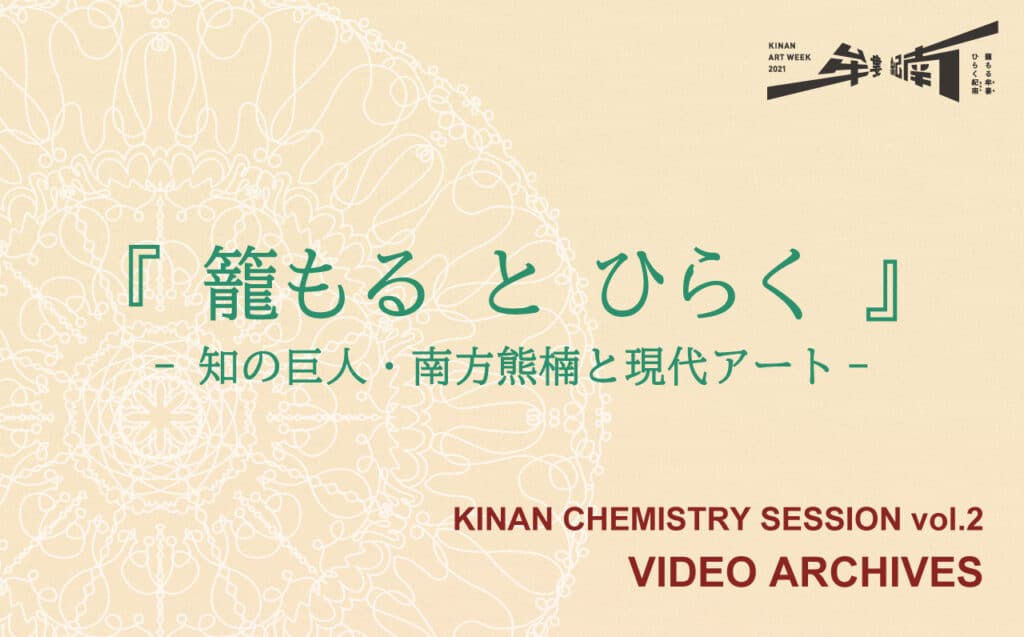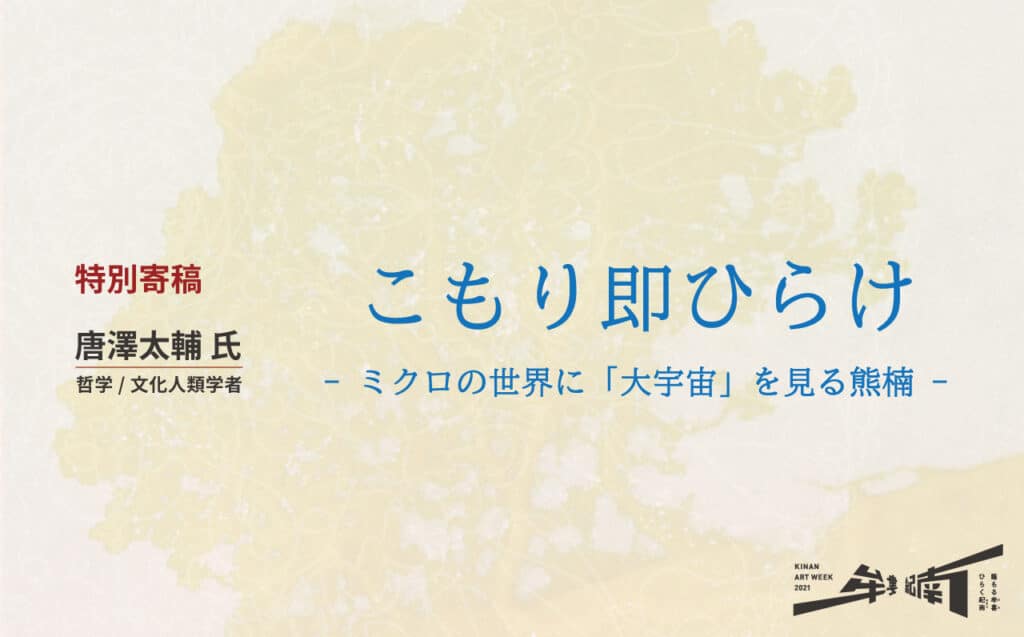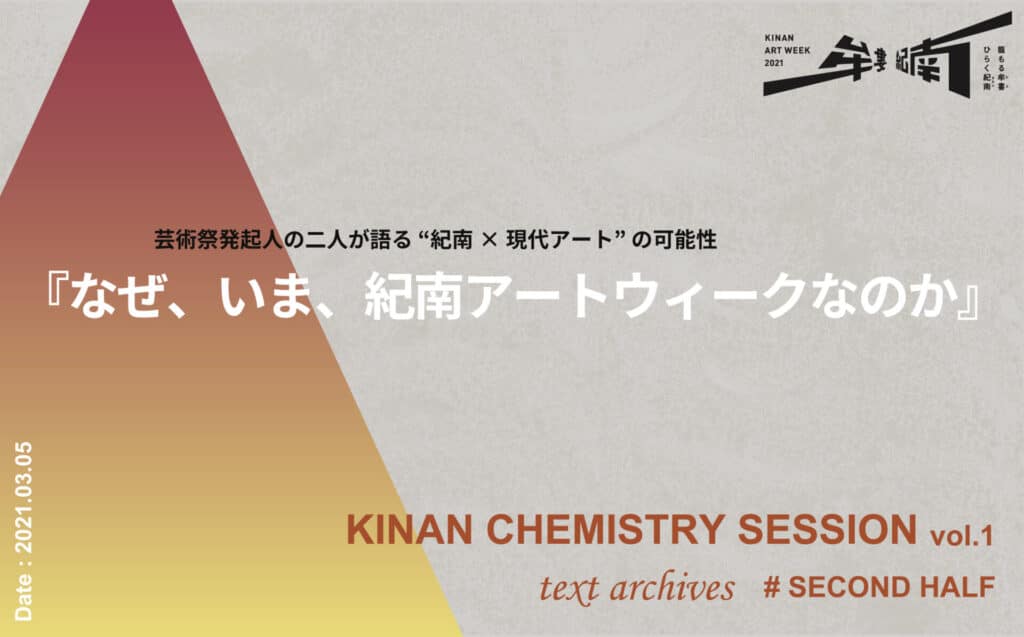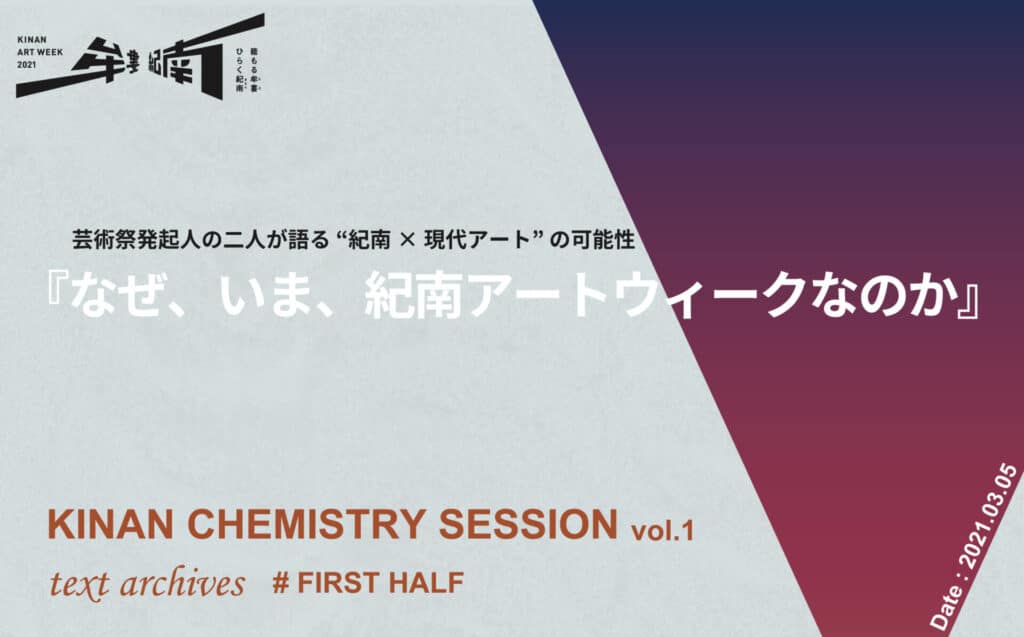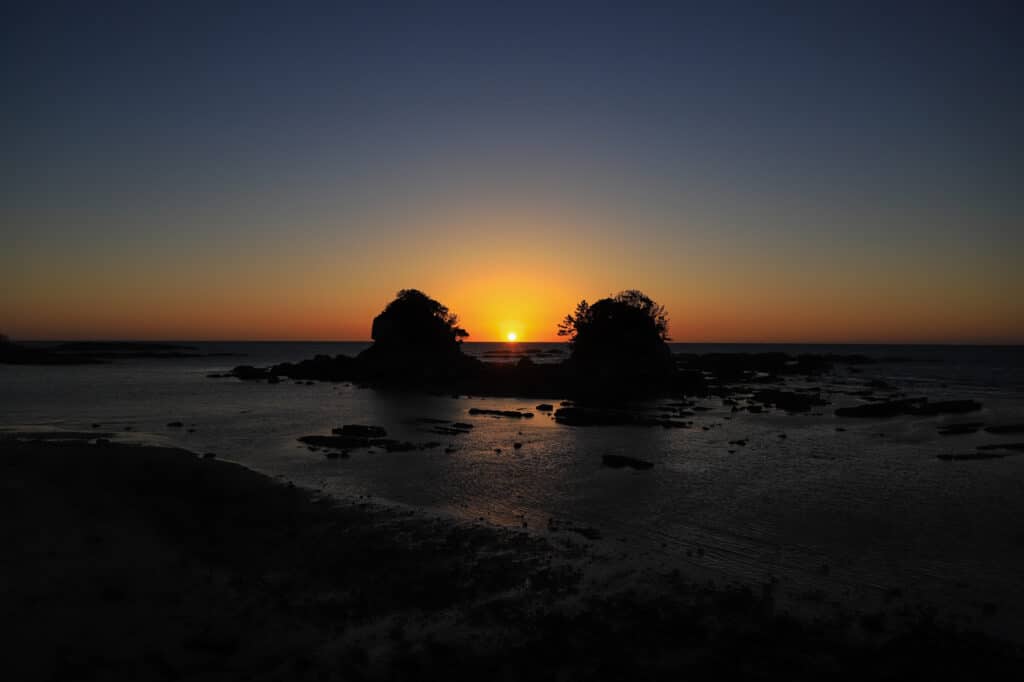Dialogue

Archived Text (First Half) of Kinan Chemistry Session vol.2 “Seclusion and Openness: Kumagusu Minakata, the Giant of knowledge and Contemporary Art”
Online talk session “Kinan Chemistry Session vol.2” held on May 28, 2021
This is the first half of a text archive that transcribes an incandescent session.
*Click here for the video archive
https://kinan-art.jp/en/info/792/
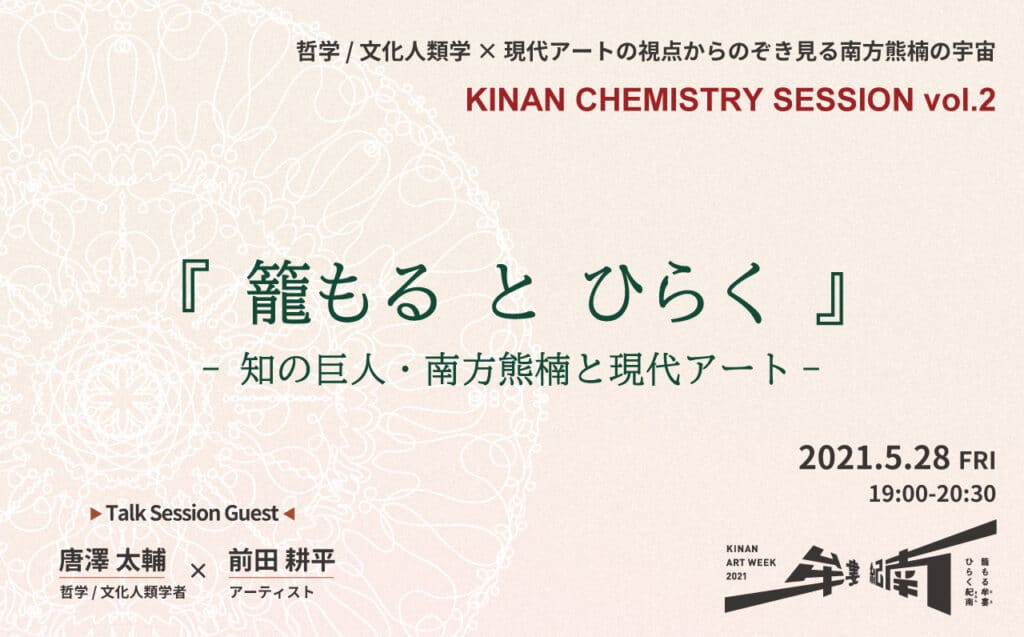
Title: “Seclusion and Openness – Kumagusu Minakata, the Giant of Knowledge and Contemporary Art – ”
Date and Time: Friday, May 28, 2021, 19:00 – 20:30
Venue: Online (ZOOM webinar)
Participation Fee: Free
Speakers: Taisuke Karasawa (Associate Professor of Philosophy / Cultural Anthropology, Akita University of Art)
Kohei Maeda (Contemporary Artist)
Moderator: Daisuke Miyatsu (Artistic Director, Kinan Art Week)
General Moderator: Ryota Morishige (Regional Revitalization Producer)
Seclusion and Openness – Kumagusu Minakata, the Giant of Knowledge and Contemporary Art –
Morishige:
Good evening, everyone.
I would like to start the 2nd Kinan Chemistry Session. I, Morishige of Nanki-Shirahama Airport, will serve as the moderator. Today, we are broadcasting from Nanki-Shirahama Airport.
The Kinan Chemistry Session is an online talk session that invites various guests to discuss the culture, history, and climate of Kinan in an inexhaustible way in preparation for Kinan Art Week 2021.
The theme of the second session is ” Seclusion and Openness – Kumagusu Minakata, the Giant of Knowledge and Contemporary Art – “. The guests will be Dr. Taisuke Karasawa, a philosopher and cultural anthropologist, and Kohei Maeda, an up-and-coming artist. The moderator will be
Mr. Daisuke Miyatsu, Artistic Director of Kinan Art Week.
First, I would like to briefly introduce the profiles of the two speakers.
Dr. Taisuke Karasawa was born in 1978 in Kobe, Hyogo Prefecture. After graduating from the Faculty of Letters, Keio University, he completed his doctorate at the Graduate School of Social Sciences, Waseda University, and is currently an associate professor at the Akita University of Art, Department of Arts and Roots, and the Graduate School of Transdisciplinary Arts. He specializes in philosophy and cultural anthropology, exploring the fundamental “ways of being” of folklore, religion, and culture, as well as the thought of the intellectual giant Kumagusu Minakata *. He has also written many books and articles on Kumagusu Minakata, and is able to talk about this difficult subject in an easy-to-understand way.
*Reference: Associate ProfessorTaisuke Karasawa(Faculty Profiles, Akita Public University of Fine Arts and Music website)
*Reference: Taisuke Karasawa(researchmap)
*Reference: Taisuke Karasawa@tisk_krsw(Twitter)
Karasawa:
Good evening, I’m Karasawa. It’s nice to meet you.
Morishige:
Next up is an artist Kohei Maeda, born in 1991 in Tanabe City, Wakayama Prefecture. Interested in the relationship and distance between people, nature, and things, he continues his journey of exploration through various approaches such as video and performance, using his own experiences. Recent projects include “Mandarabo,” an exploration of the philosophical thought of Kumagusu Minakata, and “Pangasianodon Gigas,” a search for catfish in Thailand*, both of which are very interesting. Currently, he is based at SSK (Super Studio Kitakagaya) *, a shared studio in a former shipyard facility in Osaka.
*Reference: works(Kohei MAEDAportfolio site)
*Reference: Super Studio Kitakagaya -Artist space in KitakagayaOsaka
Maeda:
I’m looking forward to working with you.
Morishige:
It was Kumagusu Minakata who brought these two together, and I hope to hear more about their encounter and relationship in the talk session to come.
The moderator, Mr.Miyatsu, please introduce yourself.
Miyatsu:
Good evening, everyone. I’m Daisuke Miyatsu.
The Kinan Art Week, including the Kinan Chemistry Session, is sponsored by Adventure World and Kinan Bank. Thank you very much for your support.
【1】 Mr. Karasawa’s history and the philosophy of Kumagusu Minakata
Miyatsu:
I will now proceed with the chemistry session.
Today’s theme is “Kumagusu Minakata, a giant of knowledge, and contemporary art. ”At first glance, they seem to have no connection, but when they are combined, a chemical reaction occurs. I would like to talk about this theme in detail.
Earlier, Mr. Morishige introduced you, but could you both introduce yourselves a little more in detail, including your relationship with Kumagusu Minakata?
Let’s start with Dr. Karasawa.
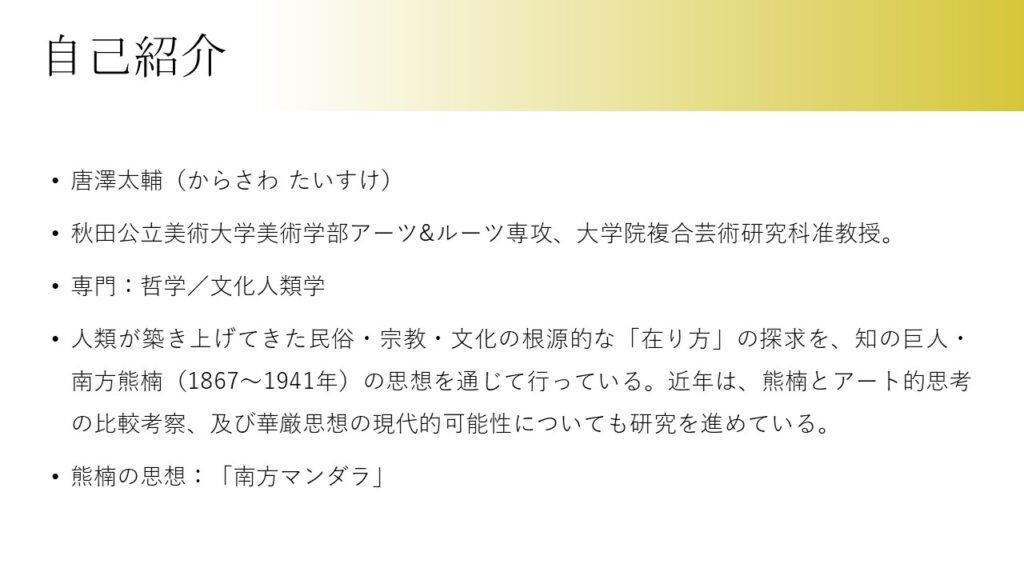
Karasawa:
My name is Taisuke Karasawa. My specialty is philosophy/cultural anthropology, and through the thought of Kumagusu Minakata, I am exploring the roots of folk customs, religions, and cultures that have been built up by humankind. Recently, I have been examining the contemporary possibilities of Kegon thought and the relationship between Kumagusu and art. In addition, I have been collecting and studying slime mold, which Kumagusu was particularly interested in.
The “Minakata Mandala” and the Five Wonders

Karasawa:
What can be considered as the core of Kumagusu Minakata’s thoughts is what is called “Minakata Mandala *1“. It is a very strange diagram, but in this diagram, Kumagusu’s unique cosmology is expressed. Kumagusu shows five kinds of realms. Uniquely he call thease realms “fushigi *2” (≒wonder) in this diagram.
The first is “monofushigi (the wonder of substance)”. It refers to the realm of things that we see as objects, the realm that is captured by physics and science.
The second, “kokoro fushigi (the wonder of heart-mind)”, refers to the realm of the mind, the so-called field of study in psychology.
The third “koto fushigi (the wonder of facts or events)” is a place where the mind and things interact in a moderate way. It is a “place” where there is an appropriate distance in the real world, where the mind does not dominate things, nor do things dominate the mind.
The fourth is “ri fushigi (the wonder of principles)”. It is the interface between the self and others, or between the primordial field and the real world. According to Kumagusu, it also includes things that can be known by precognition or the sixth sense. It is a subtle and exquisite realm, where things are barely distinguishable, yet mixed together.
The fifth and final one is the “dai fushigi (the great wonder of Buddha Dainichi)”. It is a fundamental place where no human laws can be established and where self and others are all fused and unified. It is a place where there is no inside or outside, where everything is complete.
Kumagusu believes that it is impossible for human beings to capture “dai fushigi”, the great wonder, but we may be able to think up to “ri fushigi”, the wonder of principles. In “ri fushigi”, what is called “emergence”, such as synchronicity, coincidence beyond coincidence, happens as a matter of course. Kumagusu independently named this phenomenon “Yariate *3”.
*1 drawing made by Minakata Kumagusu in a letter to his friend Dogi Houryu.
Taisuke Karasawa, “[Research Paper,Working PaperReport] The Contact Point between ‘Southern Mandala’ and ‘Kegon SutraReport on Research Activities in 2015,Ryukoku University Center for World Buddhist Culture,March31,2016,p. 191-212, Ryukoku University Library
*2 Teachings of Buddha . It is beyond human understanding and recognition. Something that cannot be expressed in words.
What is wonderKotobank
Kumagusu uses These “wonders” as the words that uniquely “realms” or “place”.
*3 Coined by Kumagusu Minakata, it refers to discoveries, inventions, and targets that are beyond the realm of chance.
Taisuke Karasawa, “Bricoleur Kumagusu-On ‘Yaritai’ and Bricolage” (Toyo University ‘Eco-Philosophy’ Studies”March2018,vol.12p. 25-38, Toyo University Academic Information Repository
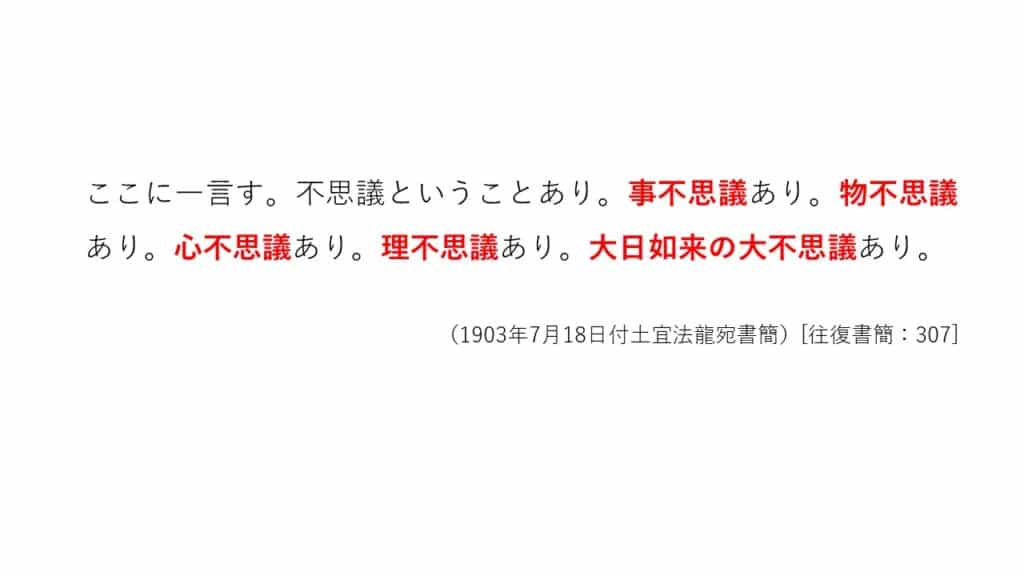
Karasawa:
“Here are a few words . There is such a thing as wonder. There is koto fushigi. There is mono fushigi. There is kokoro fushigi. There is ri fushigi. There is dai fushigi, the Great wonder of Buddha Dainichi. This phrase is Kumagusu’s explanation of “Five Wonders”.
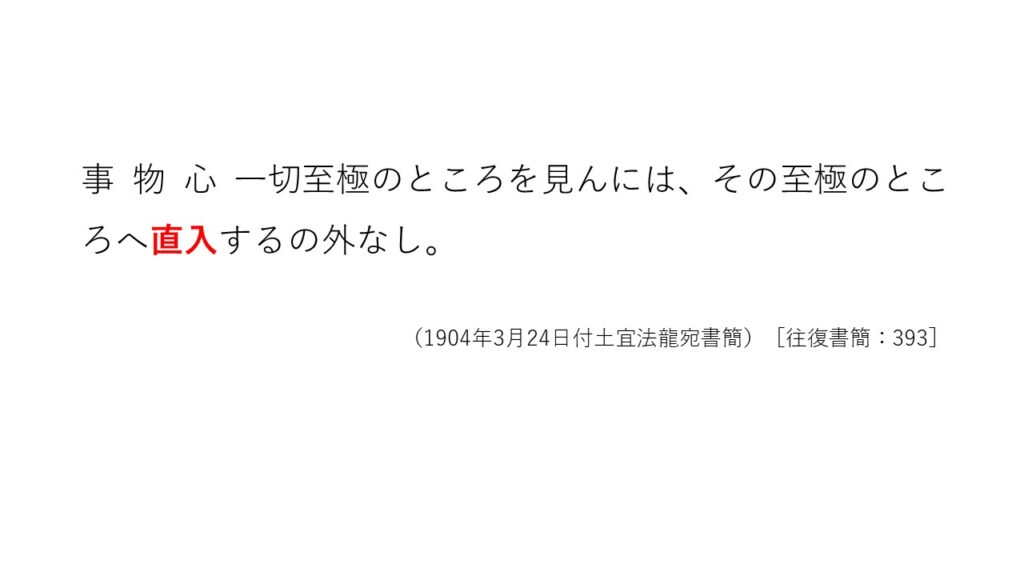
So, how can we enter into “ri fushigi”, the principle wonder and feel the power from the primordial place of “dai fushigi,” the great wonder? I will quote Kumagusu to explain.
“To see the supreme in all things, matter and mind, there is no other way but to enter directly into the supreme.”
The word “direct entry”, he said “jikinyu” in Japanese, means to go deeper than the real world, such as to things, objects, and the mind, or to “ri fushigi (the wonder of principles),” which is closest to the great wonder.
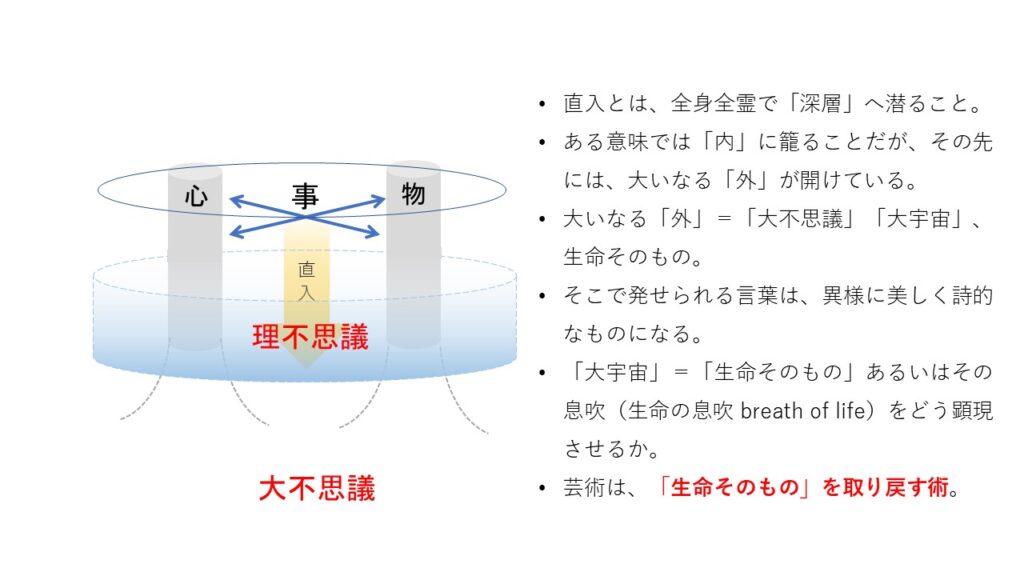
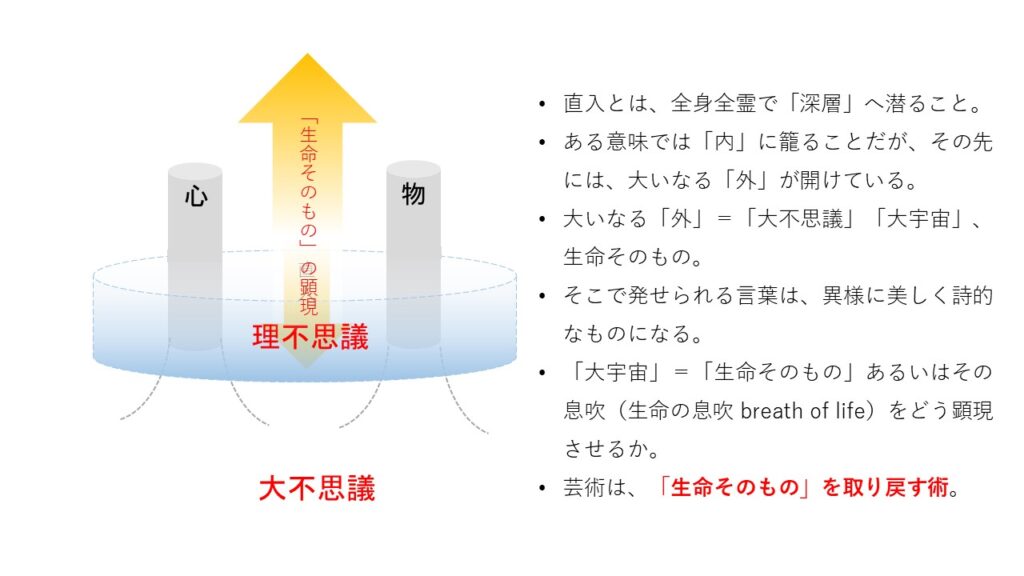
Karasawa:
Kumagusu used the word “direct entry”, which means “to dive into the depths with the whole body and soul”, not just with your head. It can also be thought of as “going inward,” but beyond that, there is the great wonder, a great outward opening. I think this is exactly what the title of this session, “Seclusion and Openness,” is all about.
When you enter into “ri fushigi” that is extremely close to the great wonder, the words you utter become unusually beautiful and poetic. First of all, there are “things, objects, and the mind”, and when you go deeply and directly into them and assemble what you have sensed from the great wonder, the macrocosm, life itself, or its breath becomes apparent. I believe that art is the way of restoring “life itself”.
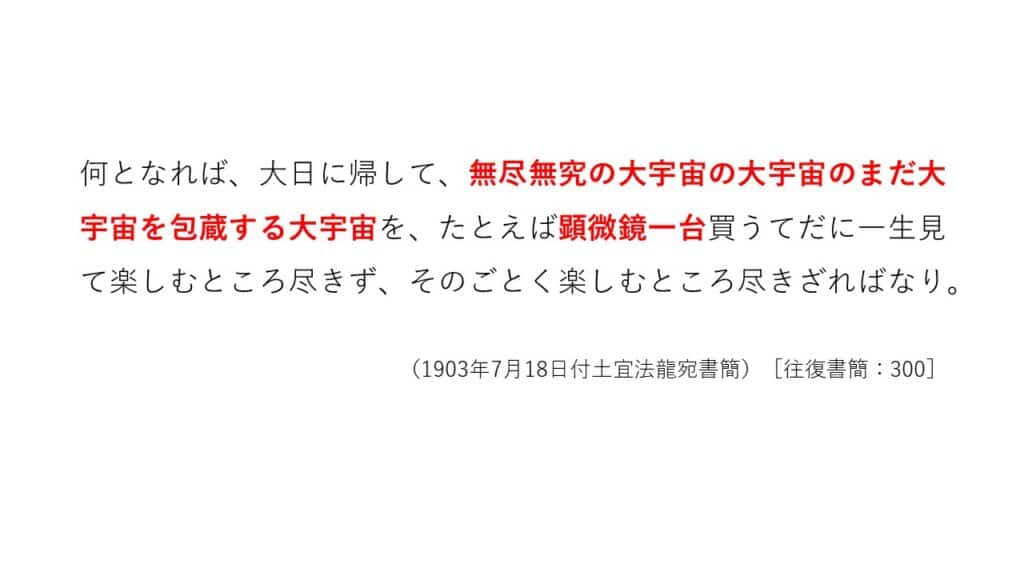
Karasawa:
In the words of Kumagusu:
「何となれば、大日に帰して、無尽無究の大宇宙の大宇宙のまだ大宇宙を包蔵する大宇宙を、たとえば顕微鏡一台買うてだに一生見て楽しむところ尽きず、そのごとく楽しむところ尽きざればなり。」(=“What if I were to return to Dainichi Buddha, and enjoy the great universe that still contains the universe of the inexhaustible universe, for example, if you were to buy a microscope, you would never run out of places to look at. There would be no end to the pleasure from doing so.“)
Kumagusu spent his days and nights looking at microscopic organisms, such as slime mold, under a microscope to discover the macrocosm and life itself. In other words, Kumagusu was able to see the macrocosm through a microscope, instead of a telescope. The observation of slime mold through a microscope can be considered as “secluding inside”, but in fact, it is a simple expression of the fact that the macrocosm is expanding beyond the microscope, and the inside is directly connected to the outside. It’s like a poem., isn’t it?
The mysterious creature “slime mold”
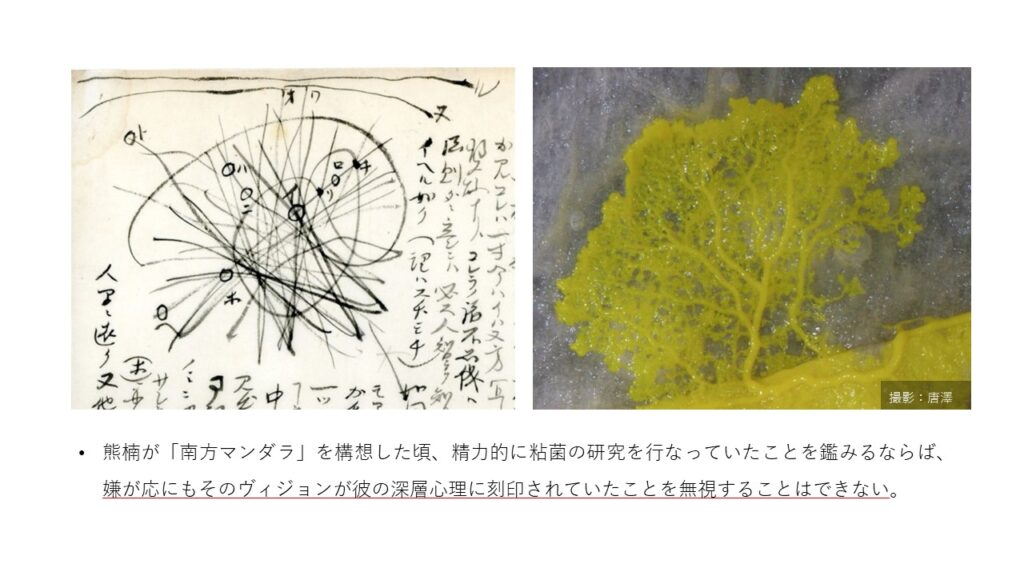
Karasawa:
The yellow thing on the right side of the Minakata Mandala is a “deformed fungus *“, which is a slime mold. The words used by Kumagusu in his explanation of the Minakata Mandala show the influence of Kegon thought *.
I am focusing on the fact that the shape of the Minakata Mandala and the slime mold are extremely similar. The slime mold is intricate and has a Mandala-like feel to it.
In fact, Kumagusu wrote the Minakata Mandala on July 18, 1903*, the month of July being the most active time of the year for slime mold. Therefore, we can’t ignore the fact that the visions of slime mold were engraved in his mind.
*Reference: Mini Encyclopedia of Transforming Fungi (The World of Transforming Fungi, National Museum of Nature and Science website)
*Reference: Taisuke Karasawa, “Minakata Kumagusu and Buddhism-Influence of Kegon Thought and Shingon Esoteric Buddhism” (Theory,November1,2017, Chugai Daily News)
*Reference: Letters to Horyu Togi (Minakata Mandara, etc.) (Minakata Kumagusu Hall of Fame)
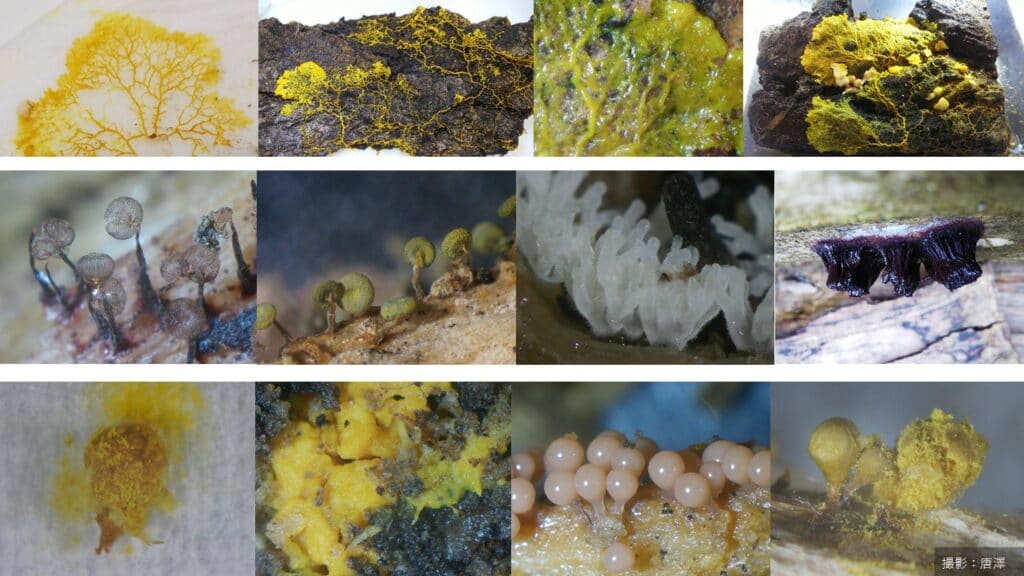
Karasawa:
What you see in this slide are the slime mold I collect and observe. They come in a variety of colors and shapes, the amoeba-like ones are called “plasmodium” and the mushroom-like ones are called “fruit bodies” *.
The more I look into slime molds, the more interesting it becomes. They may look like mushrooms, but then they produce spores, which gather together to form an amoeba. They are very mysterious creatures, and it is difficult to distinguish what is “alive” and what is “dead.
*Reference: Life History of Transforming Fungi (The World of Transforming Fungi, National Museum of Nature and Science)
Activities of the Slime Mold Research Club at Akita University of Art
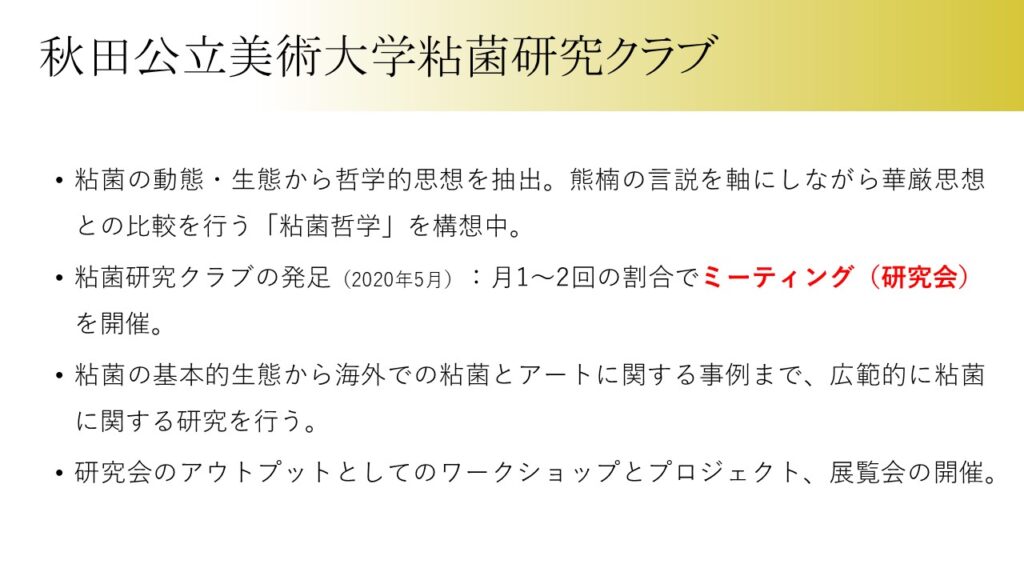
Karasawa:
I am currently organizing a “Slime Mold Research Club *” at Akita University of Art, and am involved in various activities. We study the slime mold’s mode of life to extract philosophical elements, and hold research meetings once or twice a month to study the trends of slime mold and art overseas. As an output, we organize workshops, projects, and exhibitions.
*Reference: Akita Public University of Arts,Mucus Research Club@nenkin.art(Facebook)
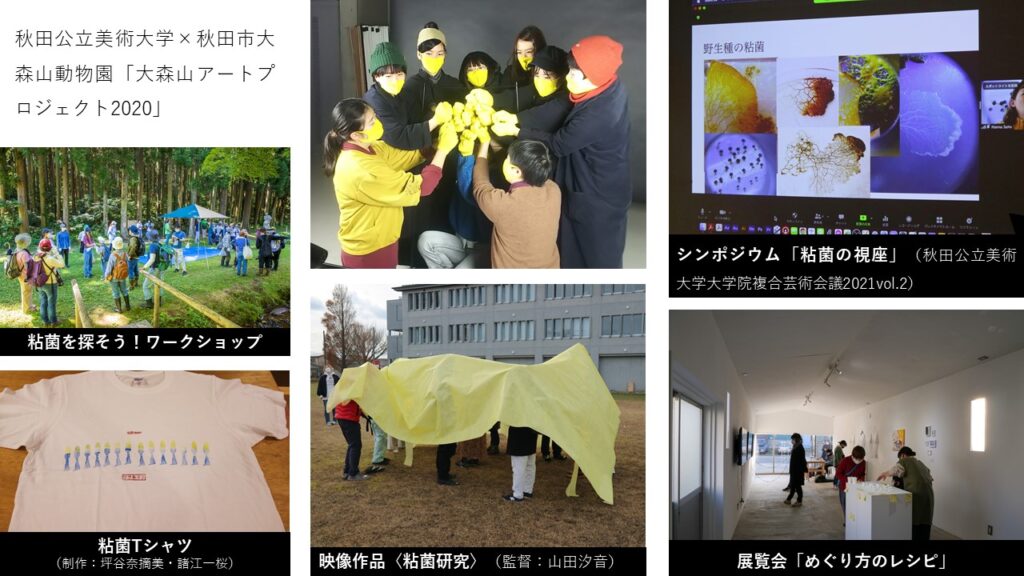
Karasawa:
The picture on the slide shows the “Let’s find slime mold! Workshop” held last year. We went to a park in Akita Prefecture, which is rich in nature and full of slime mold, to collect and observe slime mold.
We also made slime mold T-shirts and stamps made of erasers, and produced a video work, “Research of Slime Molds *,” in which we challenged ourselves to see how close we could get to slime mold. In addition, we have held symposiums and exhibitions.
*Reference: Mucus Research-Omoriyama ZooandAkita Public University of Art (Akita Public University of Art,YouTube)
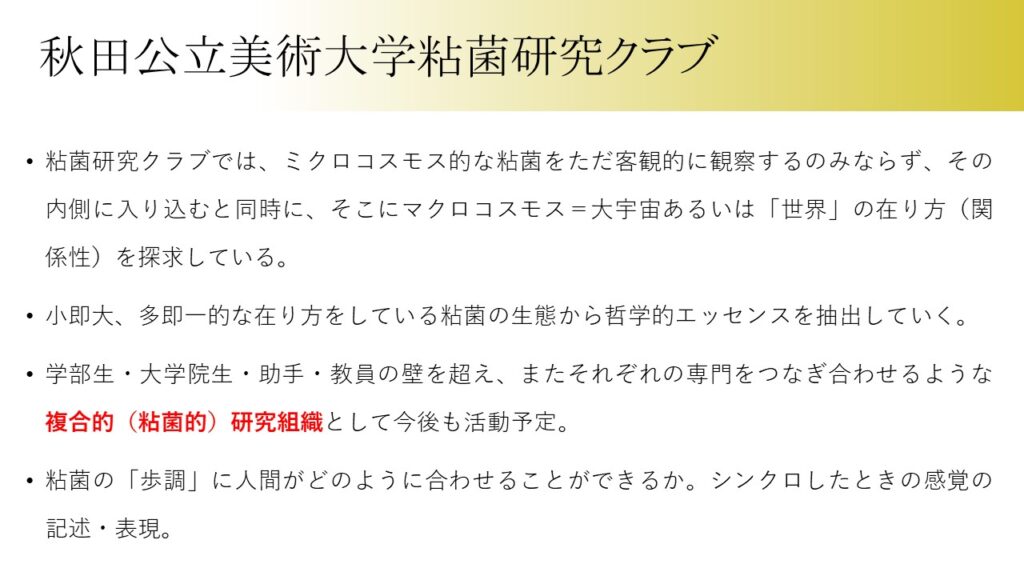
Karasawa:
In the Slime Mold Research Club, we not only observe microscopic slime mold objectively, but we also go inside it and think about what the perspective of slime mold is. Through our activities, we are exploring the “macrocosm,” or the way the world is, and the relationship between the two.
Slime mold has a “small is big, many is one” way of being. Slime mold is a multinucleated single-cell organism, which means that it has many nuclei but is a single cell. In other words, it is both many and one. In the sense that we can see the macrocosm in the microscopic world, it is also “small and big”. I find a philosophical essence in such a slime mold’s mode of life.
The members of the Slime Mold Research Club include undergraduates, graduate students, research assistants, faculty members, and many others, but we plan to continue to work as a complex, slime mold-like organization. We would like to explore how humans can match the “pacing” of the slime mold, and what happens when we synchronize.
What does “roots” mean?
Miyatsu:
Thank you very much, Dr. Karasawa.
I have one question about the department of “Arts and Roots” at Akita University of Art, where Dr. Karasawa is an associate professor: what does “roots” mean?
Karasawa:
There are many folk and cultural resources in Akita, and through fieldwork we are trying to find the root of culture, folklore, and religion. In this department, we try to absorb them and express them in what way We can. That is why We use the word “roots” in the sense of “origin”.
*Reference:Akita Public University of Fine Arts and Music (AkitaPublicUniversity of Fine Arts and Music website)
Miyatsu:
I see. I understand now. Thank you very much.
Like his research on slime mold, Kumagusu’s research is interdisciplinary and crosses various fields.
Karasawa:
That’s right. It is difficult to present Kumagusu as a particular —ist. He was a philosopher, ecologist and a folklorist. I once looked up Kumagusu’s titles, and found more than 60 (laughs). That’s how much he is beyond the frame or definition of “—ist”.
【2】 The relationship between Mr.Maeda and art
Miyatsu:
Next, we have Kohei Maeda. I think those of you who are participating today are especially interested in what kind of work you are creating, so please introduce yourself.
From Canoeing to the World of Art
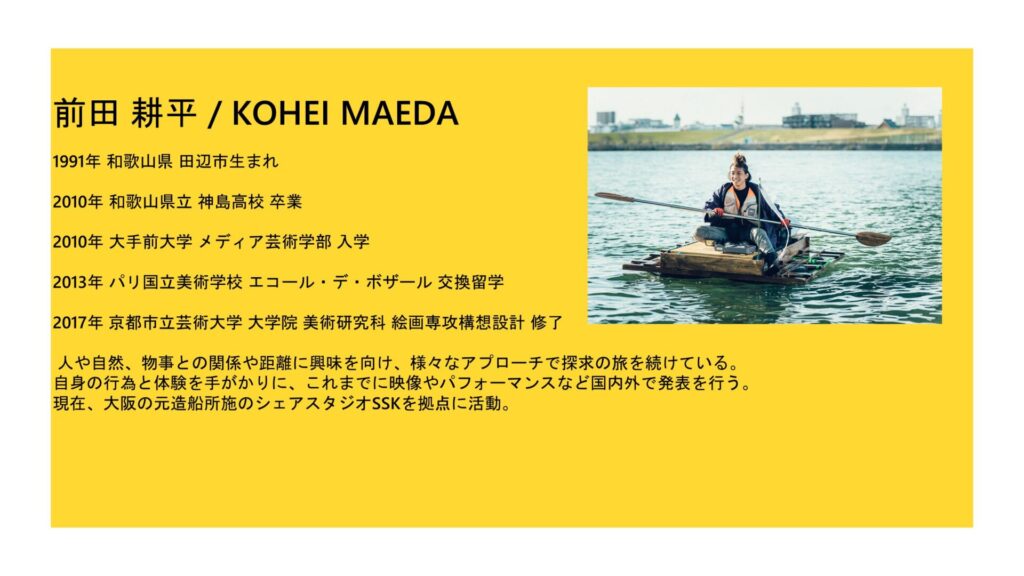
Maeda:
My name is Kohei Maeda.I am very nervous to be allowed to give a talk together with Dr. Karasawa (laughs). I will tell you about my encounter with Kumagusu Minakata and Dr. Karasawa later, but first, let me introduce myself briefly.
I was born in 1991 in Tanabe City, Wakayama Prefecture. I went to school in Tanabe City from elementary school to high school, and I grew up in Tanabe City until I was about 18 years old.
Ever since I was in elementary school, I would gather my friends together to shoot movies on home video and go out to take pictures. Of course, I also liked to draw.
After entering Kashima High School, I joined the canoe club and competed in canoeing for three years. As I continued canoeing, I began to feel that it was more fun to take pictures of the places I visited for practice and competitions, such as rivers and lakes, and of the athletes who were active, rather than the competition itself. While paddling a canoe, I thought to myself, “this is something I might want to do, ” and decided to pursue a career in art.
After graduating from high school, I enrolled in the Faculty of Art at Otemae University in Hyogo Prefecture, and during my senior year, I had the opportunity to study abroad in France, which was my first encounter with contemporary art.
After that, I went on to graduate school at Kyoto City University of Arts and began to study contemporary art in earnest. I was at a point in my life where I wanted to know more about ”what my own expression would be like. What kind of things am I interested in?”
Activities at the shared studio “SSK”
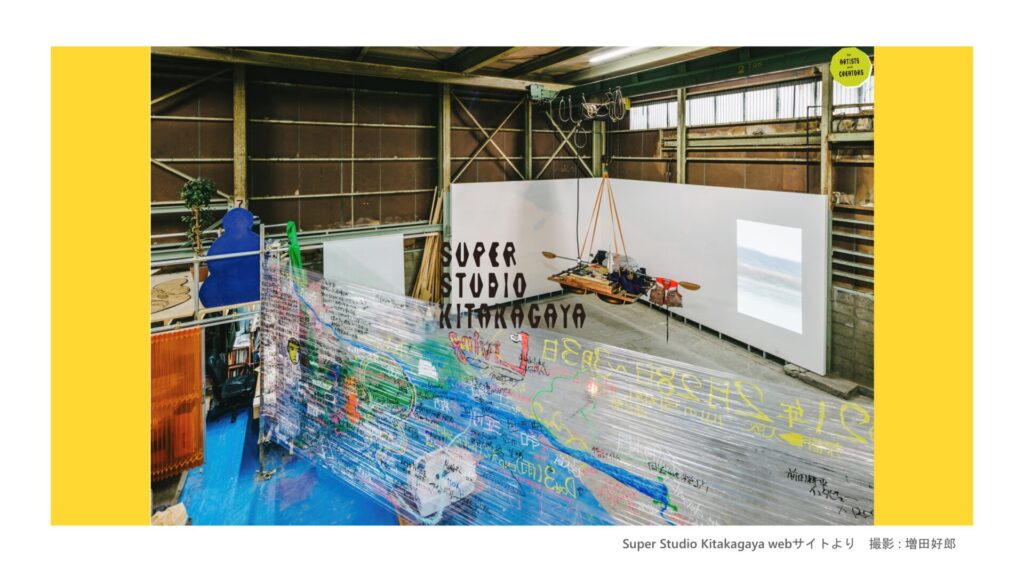
Maeda:
I am currently based at SSK, a shared studio in a former shipyard facility in Osaka. There are more than a dozen artists in the studio, each creating their own works.
The photo in the slide shows the area I usually use. With the high ceiling, I can create large works of art, or do detailed work such as editing video works.
The area in the back with the ship-like artwork is the gallery space. You can experiment with the display of your own work, projecting images inside the work, hanging the work itself, and so on.
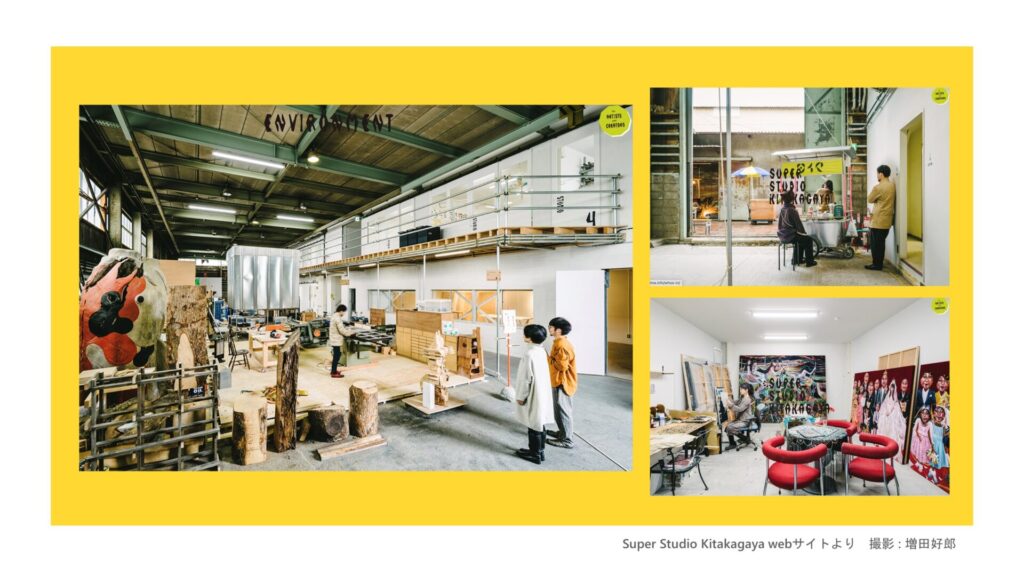
Maeda:
The studio is huge, and there are many different people in it. There are people who are carving wood, drawing pictures, researching food stalls, etc. They are all working professionally. I enjoy doing this every day because it gives me a different kind of stimulation from what I had at the university.
Why do you want to include ”yourself” in your work?
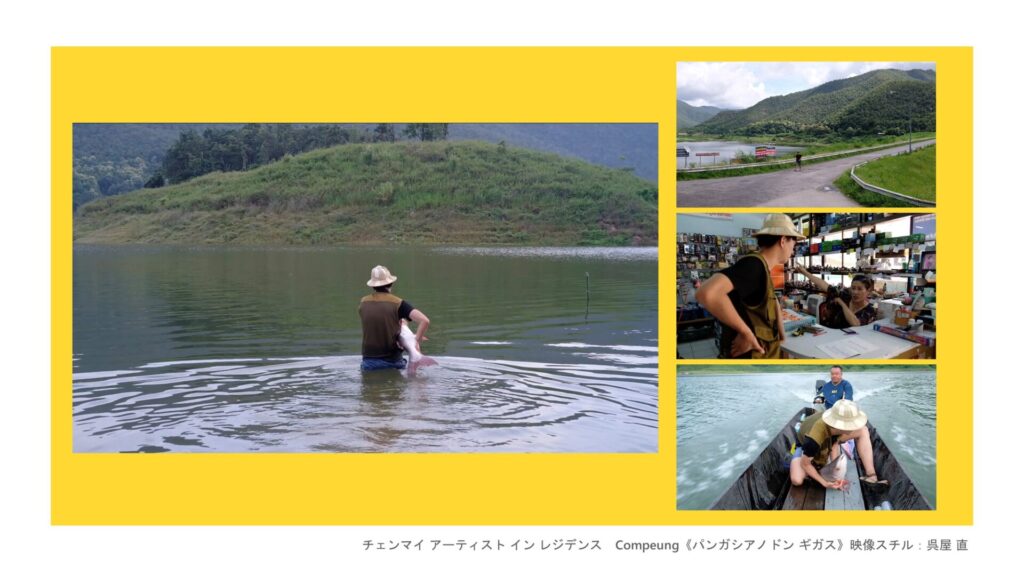
Maeda:
In many countries around the world, there are “artist-in-residence *” programs that allow artists to stay in various places and create works of art, and I used this program to create a video called “Pangasianodon gigas” in Chiang Mai, Thailand. I made the video with the Mekong giant catfish in mind, and you are able to see how the Thai people live. We have prepared a 1 minute digest video, so please have a look.
*Reference AIR_J: Comprehensive website for Artist-in-Residence programs throughout Japan
*Reference Res Artis – Worldwide Network of Arts Residencies
Maeda:
Thank you for watching.
As you can see in the digest video, many of the video works I make feature myself. I would like to continue to refine my physical expression as a performance and my expression as a video work, as I often create video works that have documentary elements through my own actual experiences.
Exhibition methods that make use of space and flat surfaces
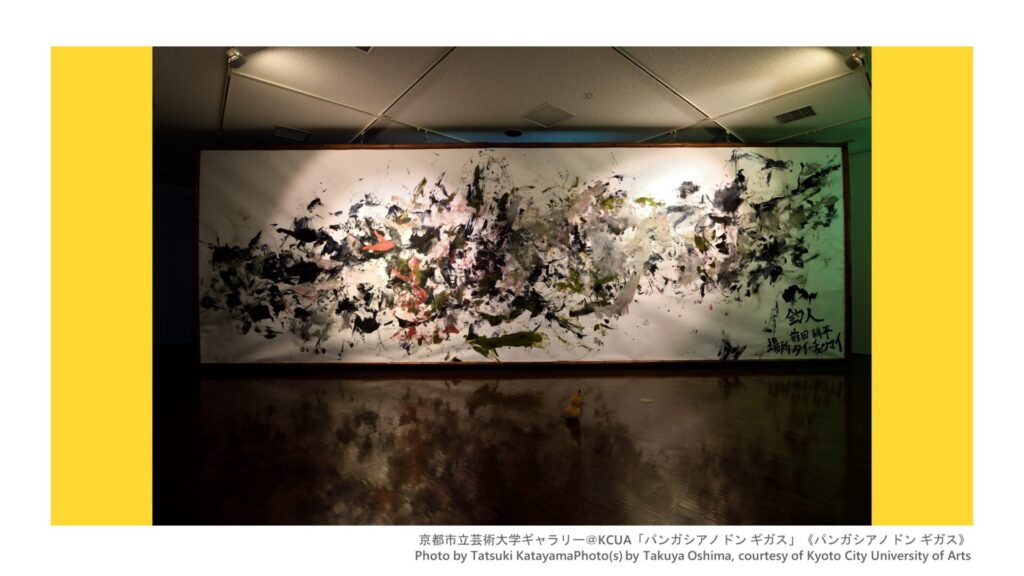
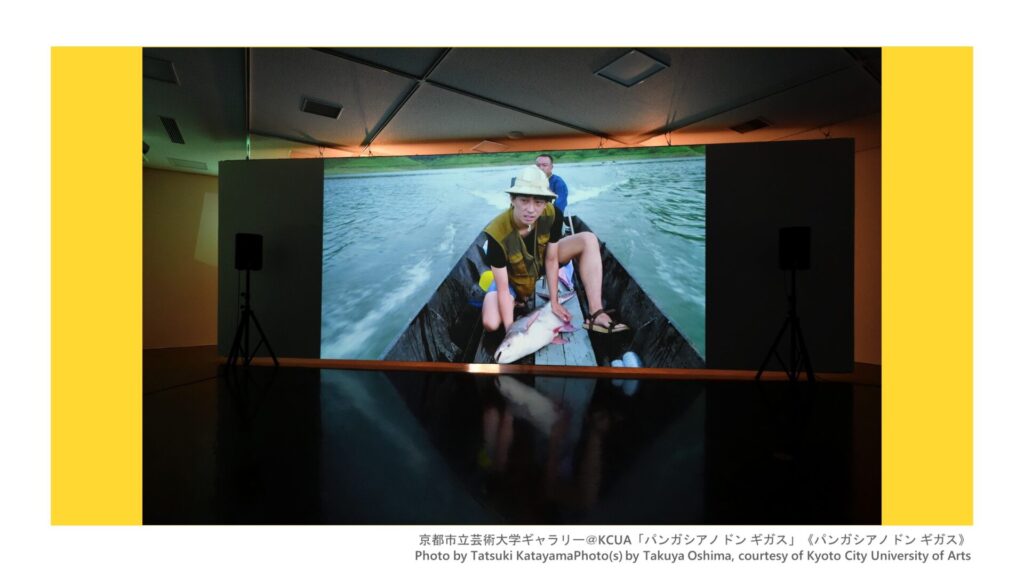
Maeda:
I often present works that use space, but in my awareness of my relationship with space, I sometimes use “two-dimensional expressions” such as drawings and photographs to convey what I am thinking.
This painting is about 8 meters long, but actually, the digest video you saw earlier is projected on the back of the painting. In this way, I am also thinking about the mechanisms within the space.

Maeda:
Sometimes, I display three-dimensional objects that fill the entire space. This is a picture of a three-meter-long clay papier-mache exhibit.

Maeda:
I would also like to exhibit videos and photos in various rooms, so that I can communicate my thoughts in various ways.
Exhibit his work in public spaces.
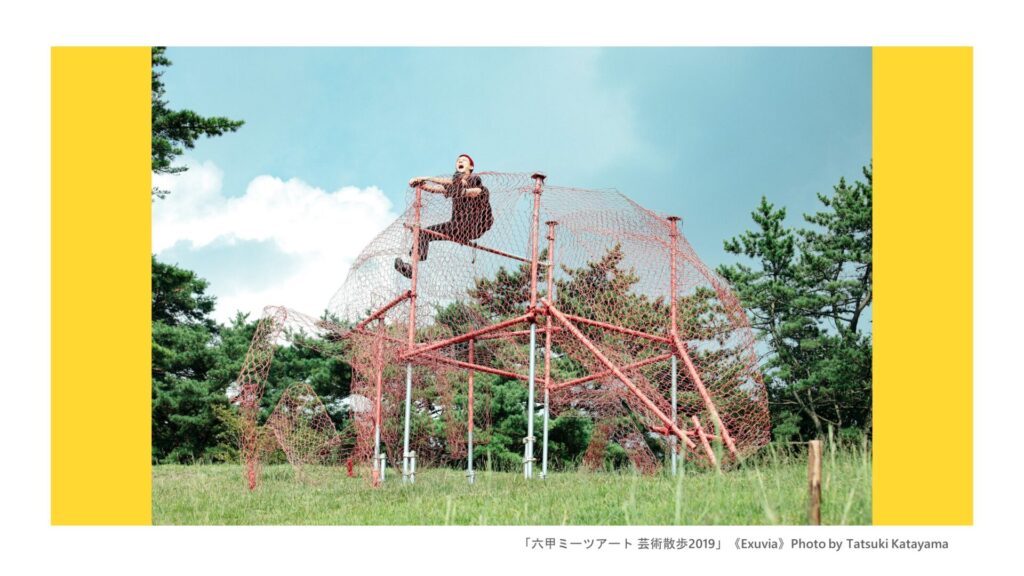
Maeda:
Recently, I have been using public spaces such as art festivals and performing outdoors with my own body along with three-dimensional objects.
This photo was taken when I received the Kobe Mayor’s Award at the “Rokko Meets Art” Art Festival *. It was a performance in which I entered a cicada shell made of wire netting, poked my face out of the crack of the shell, and screamed.
*Reference: “The Grand Prize has been decided!(Notice,September11,2019, Rokko Meets ArtArt Walk2019)
*Reference “[Alumnus|Kohei Maeda]Won the Kobe Mayor’s Award for ‘Rokko Meets Art Art Walk2019′” (The NewestOctober6,2019Otemae University)
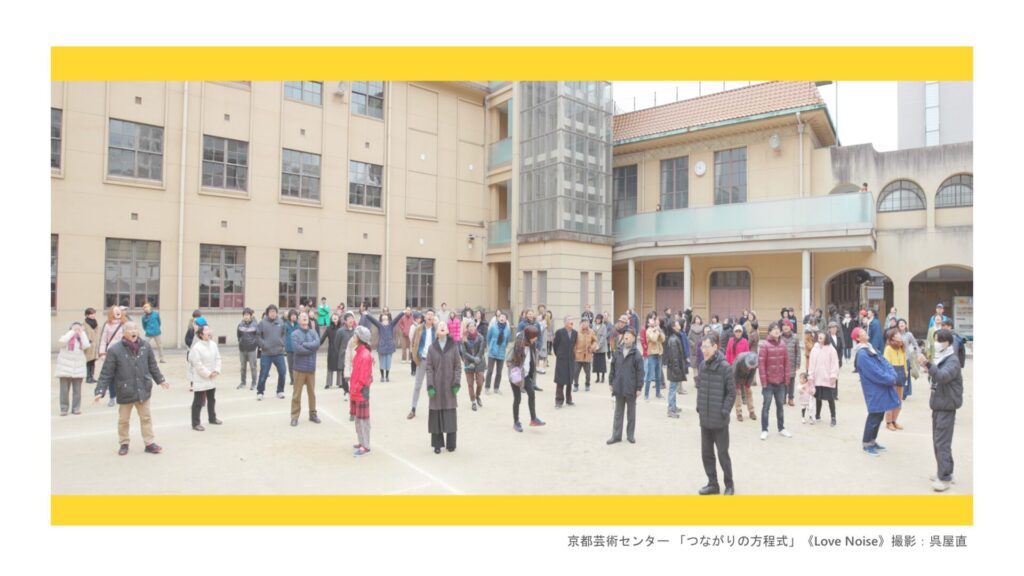
Maeda:
One of my other approaches is to work together with many people to achieve something from that which has no substance. I shoot a record of this and make a video. I also take a bird’s eye view of phenomenal things, with myself in the work.
“If we make this one, let’s do this next! ” And so on and so forth, the ideas never stop flowing and the work continues.
What are Mr. Maeda’s “roots”?
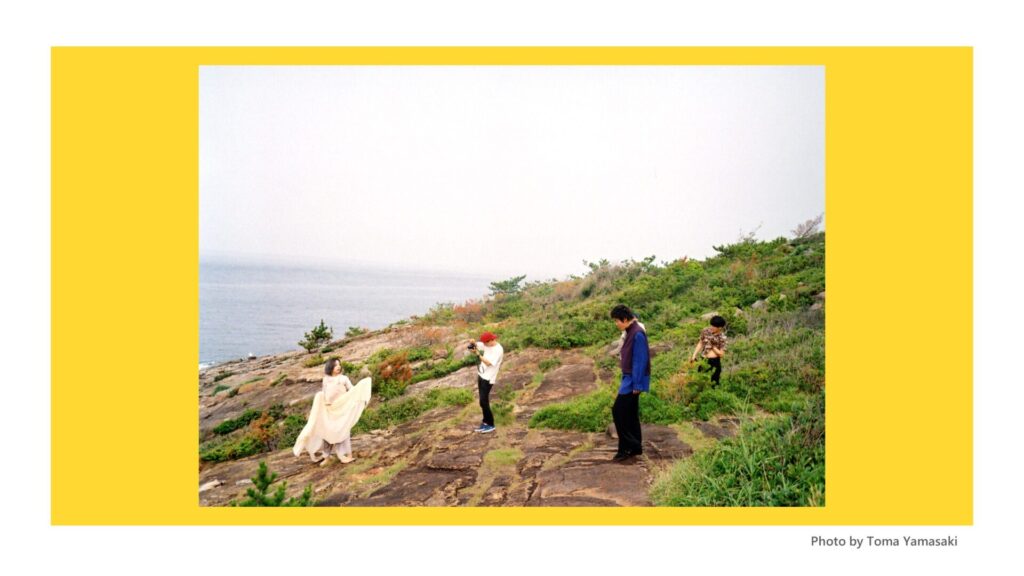
Maeda:
The roots of this kind of work can be found in my research theme in graduate school. In graduate school, we have to focus on a single theme, and when I was discussing this with my professor, we talked about Wakayama and a man named Kumagusu Minakata, and I immediately decided, “Let’s go with that!”
After that, I conducted research on the theme of Kumagusu Minakata for two years. Kumagusu is no longer alive , so I could not talk to him directly, but I thought that recording the results of my dialogue and communication with him might lead to a new way of expression.
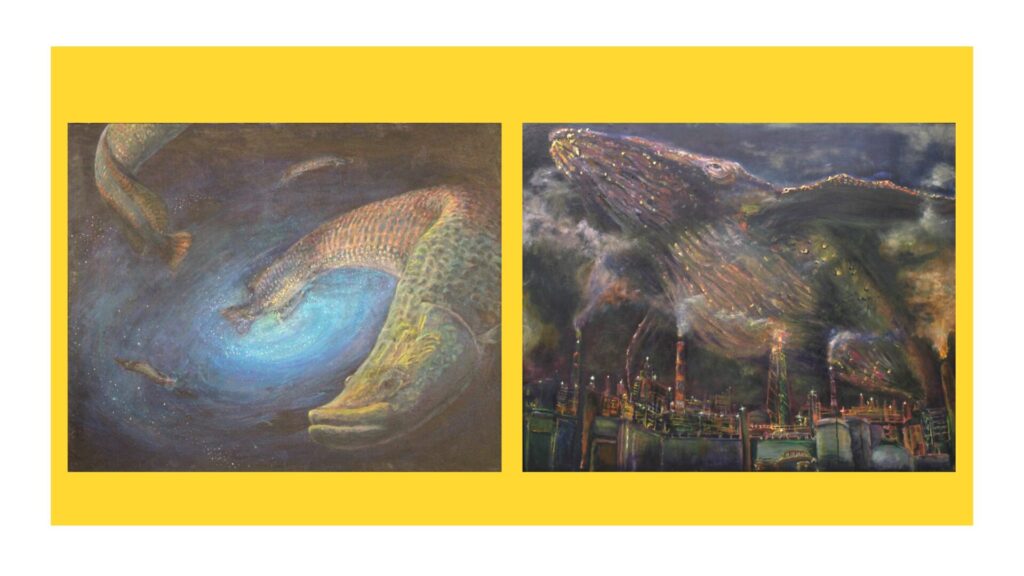
Maeda:
Originally, in my hometown, the ocean was close by, and there were also mountains and places with interesting terrain, so I often played in those places with my friends.
When I was a child, I felt close to nature, but when I entered university, I experienced the city for the first time, and a change occurred. I realized that I was wavering between being close to nature and being closer to artificial things. Gradually, I became more and more aware of the distance between me and nature. In the beginning, I was drawing pictures like this one.

Maeda:
On the slide is a book written by Dr. Karasawa called “Kumagusu Minakata: The Limits of Japanese Possibilities”. Continuing my research, I came across his book. As I researched more about Kumagusu Minakata, I began to think that Kumagusu was the one who was conscious of the distance from nature, and that had connection with what he was thinking.
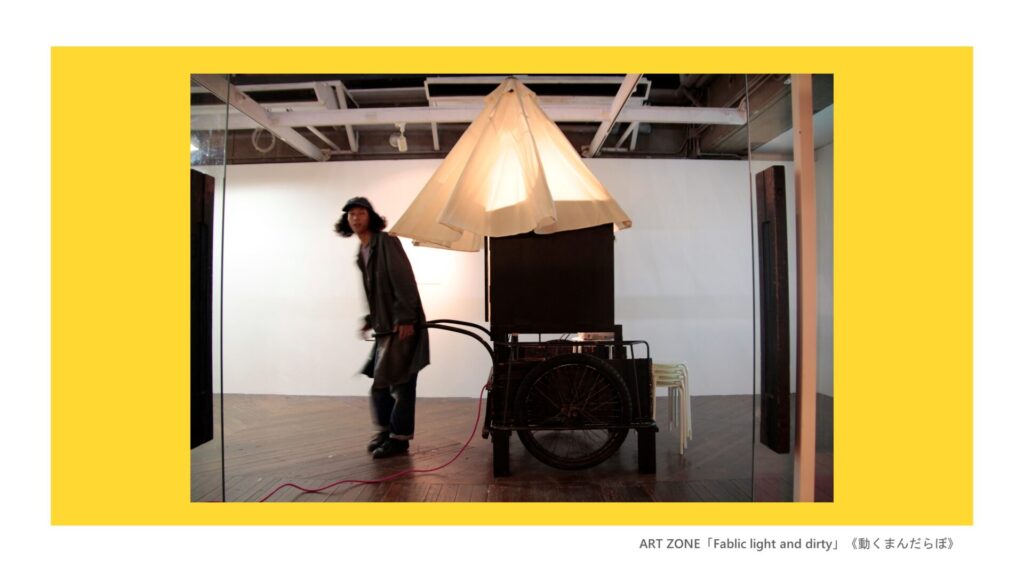
Maeda:
After that, I decided to ask for help from many people. I thought it would be interesting to create a time and place to think about the things that we all think about in our daily lives, such as the “things, objects, and minds” that Dr. Karasawa mentioned earlier. With this in mind, I launched a project called “Dynamic Mandarabo”. I developed my own fieldwork method of building a mobile research cart and going out into the city.
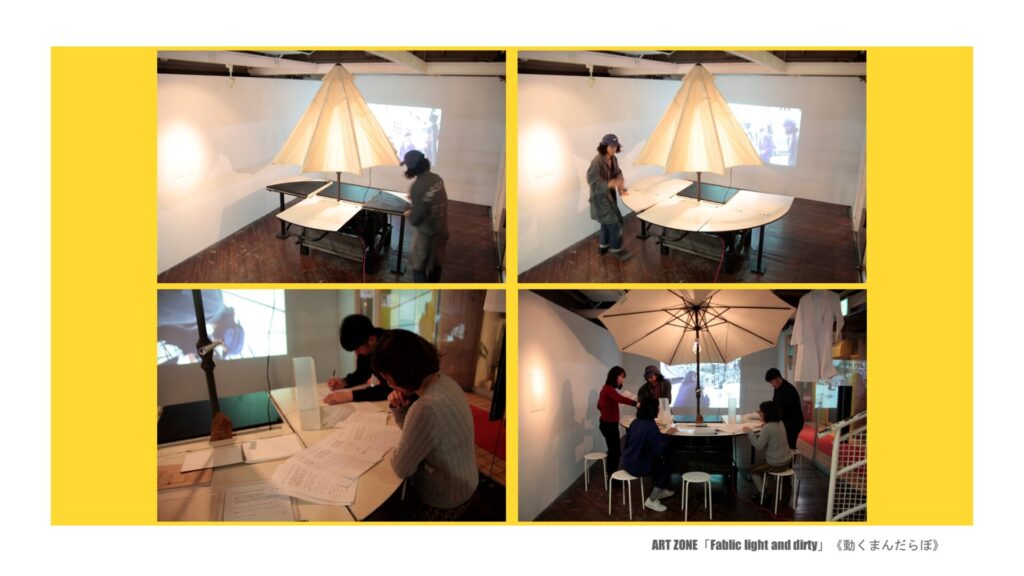
Maeda:
We also created a space like a laboratory, which when unfolded becomes a semicircle. People gathered there to think about Kumagusu together, to read books, and to talk.

Maeda:
As we continued our activities and people started to gather, I could see the situation of “thinking something together, and something fuzzy like Kumagusu’s idea rising up” in the way they were flying the big kites.
The face on this kite is a mixture of Kumagusu Minakata’s and mine, a face that does not exist in this world. I pulled up this kite as a symbol, together with the people who were involved at the time, and recorded it as a work of art *.
*Reference: “Over to you” (works, Kohei MAEDAportfolio site)
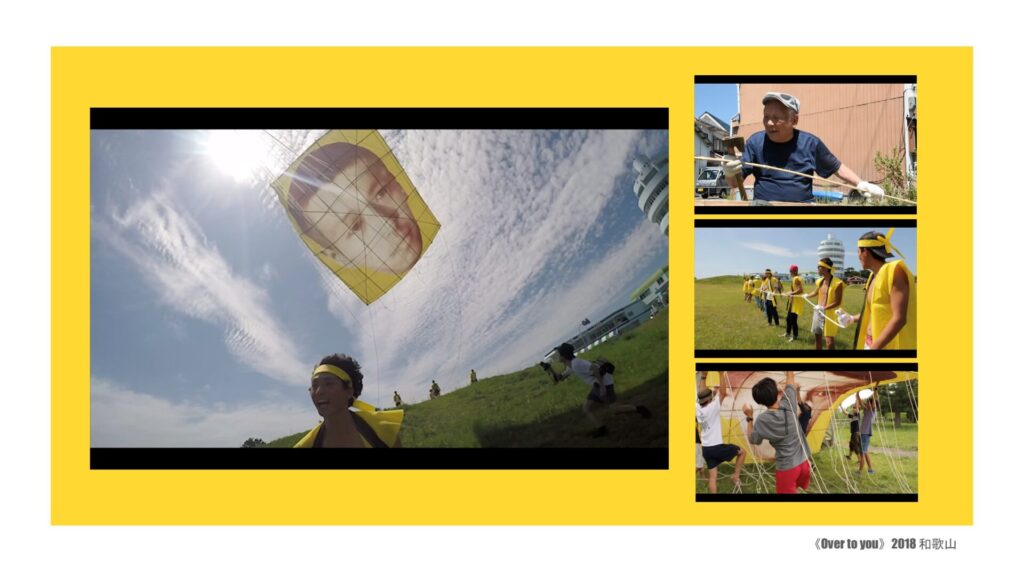
Maeda:
The kite flying was done in Kyoto and Wakayama *. This kite was made by asking some of the people who worked with me to approach Kumagusu. I asked them if they would fly it with me.
At the moment, I am planning to participate in Kinan Art Week as an exhibiting artist. Perhaps I may be able to exhibit these works somewhere, so please do let me know.
*Reference: “Over to You”COLLECTIONS,Aura Asia Contemporary Art Project)
Miyatsu:
Thank you very much,Mr.Maeda.
Now it’s time to make an announcement about what we are going to do for Kinan Art Week. However, due to the spread of the new coronavirus infection, it’s hard to see what’s going on, so we’re still trying to figure out if we can do the real Kinan Art Week or if we have to do it in a different way. We haven’t officially announced the participating artists yet, but if we do decide to have a real Kinan Art Week, we would love to have Mr. Maeda join us.
.
.
<Related article>
